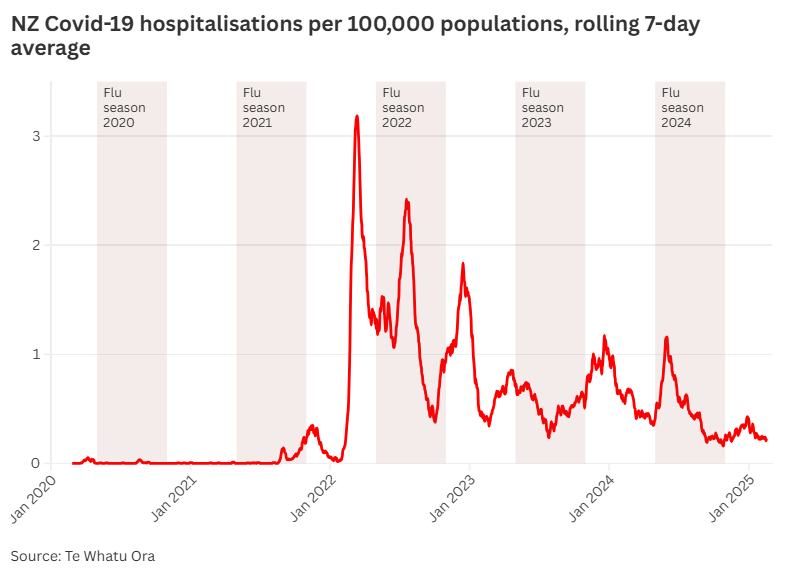References
- Baker MG, Kvalsvig A, Plank MJ, Geoghegan JL, Wall T, Tukuitonga C, et al. Continued mitigation needed to minimise the high health burden from COVID-19 in Aotearoa New Zealand. New Zealand Medical Journal. 2023;136(1583):67-91. https://doi.org/10.26635/6965.6247
- Chemaitelly H, Ayoub HH, Coyle P, Tang P, Hasan MR, Yassine HM, et al. Differential protection against SARS-CoV-2 reinfection pre- and post-Omicron. Nature. 2025. https://doi.org/10.1038/s41586-024-08511-9
- Curtis E, Jaung R, Paine S-J, McLeod M, Tamatea J, Atkinson J, et al. Examining the impact of COVID-19 on Māori:non-Māori health inequities in Aotearoa, New Zealand: an observational study protocol. BMJ Open. 2024;14(3):e083564. https://bmjopen.bmj.com/content/bmjopen/14/3/e083564.full.pdf
- Kvalsvig A, Brooks A, Potter J, Jeffreys M, Bennett J, Davies-Payne D, Kennedy J, Sika-Paotonu D, Timu-Parata C, Crossan J, Hume C, Russell L, Lorgelly P, Baker M. Long Covid in Aotearoa NZ: Risk assessment and preventive action urgently needed. Public Health Expert Briefing (26 March 2024). https://www.phcc.org.nz/briefing/long-covid-aotearoa-nz-risk-assessment-and-preventive-action-urgently-needed
- Ely WE, Brown LM, Fineberg HV. Long Covid Defined. The New England Journal of Medicine. 2024;391(18):1746 – 53. https://www.nejm.org/doi/full/10.1056/NEJMsb2408466
- Qin S, Zhang Y, Li Y, Huang L, Yang T, Si J, et al. Long COVID facts and findings: a large-scale online survey in 74,075 Chinese participants. The Lancet Regional Health - Western Pacific. 2024;52:101218. https://www.thelancet.com/journals/lanwpc/article/PIIS2666-6065(24)00212-8/fulltext
- Bartsch SM, Chin KL, Strych U, John DC, Shah TD, Bottazzi ME, et al. The Current and Future Burden of Long COVID in the United States (U.S.). The Journal of Infectious Diseases. 2025. https://doi.org/10.1093/infdis/jiaf030
- Kvalsvig A, Kerr J, Lorgelly P, Wilson N, Baker M. Long Covid: High economic burden justifies further preventive efforts. Public Health Expert Briefing. (9 September 2024). https://www.phcc.org.nz/briefing/long-covid-high-economic-burden-justifies-further-preventive-efforts
- Petousis-Harris H, Paynter J, Chisholm H, Batty K, Baker M. Robust vaccine surveillance shows safety – we need to communicate this better. Public Health Expert Briefing (19 September 2024). https://www.phcc.org.nz/briefing/robust-vaccine-surveillance-shows-safety-we-need-communicate-better
- Potter JD, Baker M, Ingram J. Covid-19 vaccines still protect us: How do we get the best out of them? Public Health Expert Briefing. (1 August 2024). https://www.phcc.org.nz/briefing/covid-19-vaccines-still-protect-us-how-do-we-get-best-out-them
- Greenhalgh T, MacIntyre CR, Baker Michael G, Bhattacharjee S, Chughtai Abrar A, Fisman D, et al. Masks and respirators for prevention of respiratory infections: a state of the science review. Clin Microbiol Rev. 2024;37(2):e00124-23. https://doi.org/10.1128/cmr.00124-23
- McAndrew F, Abeysuriya RG, Sacks-Davis R, Sammann M, Lister DM, West D, et al. Admission screening testing of patients and staff N95 respirators are cost-effective in reducing COVID-19 hospital-acquired infections. J Hosp Infect. 2024;152:81-92. https://doi.org/10.1016/j.jhin.2024.06.015
- Sun G, Lin K, Ai J, Zhang W. The efficacy of antivirals, corticosteroids, and monoclonal antibodies as acute COVID-19 treatments in reducing the incidence of long COVID: a systematic review and meta-analysis. Clin Microbiol Infect. 2024;30(12):1505-13. https://doi.org/10.1016/j.cmi.2024.07.006
- Baker M, Kvalsvig A, Tukuitonga C, Wilson N. The Covid inquiry report is an excellent guide to preparing for the next pandemic – health cuts put that at risk. Public Health Expert Briefing. (5 December 2024). https://www.phcc.org.nz/briefing/covid-inquiry-report-excellent-guide-preparing-next-pandemic-health-cuts-put-risk
- Baker M, Crump J, Kvalsvig A, Geohegan J, Tukuitonga C, Brewerton M, Kerr J, Wilson N. Why we need an Aotearoa Centre for Disease Control (CDC). Public Health Expert Briefing (16 November 2023). https://www.phcc.org.nz/briefing/why-we-need-aotearoa-centre-disease-control-cdc
- Kvalsvig A, Barnard LT, Summers J, Baker MG. Integrated Prevention and Control of Seasonal Respiratory Infections in Aotearoa New Zealand: next steps for transformative change. Policy Quarterly. 2022;18(1):44-51. https://ojs.victoria.ac.nz/pq/article/view/7500
- Kisa S, Kisa A. A Comprehensive Analysis of COVID-19 Misinformation, Public Health Impacts, and Communication Strategies: Scoping Review. J Med Internet Res. 2024;26:e56931.https://doi.org/10.2196/56931
- Baker MG, Wilson N, Blakely T. Elimination could be the optimal response strategy for covid-19 and other emerging pandemic diseases. BMJ. 2020;371:m4907. https://doi.org/10.1136/bmj.m4907
About the Briefing
Public health expert commentary and analysis on the challenges facing Aotearoa New Zealand and evidence-based solutions.
Subscribe

Public Health Expert Briefing
Get the latest insights from the public health research community delivered straight to your inbox for free. Subscribe to stay up to date with the latest research, analysis and commentary from the Public Health Expert Briefing.

